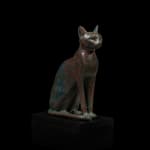Egyptian
An Egyptian bronze cat, Late Period, circa 664 - 30 BC
Bronze
Height: 11 cm
Further images
Hollow cast, depicted seated with the forelegs and paws together, the body well-modelled, the tail curled around the right side, the head with clearly-defined eyes and muzzle, a fine green...
Hollow cast, depicted seated with the forelegs and paws together, the body well-modelled, the tail curled around the right side, the head with clearly-defined eyes and muzzle, a fine green patina with attractive cuprite and azurite.
Provenance
Alexander M. Bing (1878 - 1959) Collection, New York, acquired prior to 1959, thence by descent to his son-in-lawSotheby’s, New York, 7 June 2005, lot 88
With Rupert Wace Ancient Art, London, 2005
Private collection, Switzerland, acquired from the above
Alexander Bing, alongside his brother Leo formed Bing and Bing, one of New York City’s most prolific developers, . Between 1906 and 1921, the pair built more than three dozen apartment buildings and hotels, many of which were designed by the prominent architect Emery Roth and epitomise the 'pre-war classic' style of architecture. Among them were the Alden, at 82nd and Central Park West, The Southgate Apartment Complex On East 52nd Street, 2 Horatio Street in the West Village and the Gramercy Park Hotel. The Bings 'made their names synonymous with stately, spacious apartments in elegantly detailed buildings that often had Art Deco touches,' the New York Times wrote in a 2006 feature on their Upper East Side buildings.
Alexander Bing retired from the family firm in 1921 to get involved in developing lower-income communities. In the early 1920s, he provided funding for the City Housing Corporation of New York City, which built Sunnyside Gardens in Queens, and the planned community of Radburn in New Jersey, which introduced concepts like the cul-de-sac and interior parklands. He was also a patron of the arts and a renowned philanthropist, bequeathing art to the Metropolitan Museum of Art, New York, on his death.
Literature
The cat was sacred to the goddess Bastet. A cat-headed goddess of protection, good health and fertility, Bastet was originally a fierce warrior goddess, but came to embody more domestic functions of household protection and as a goddess of pregnancy and childbirth.Her cult centres, called Bubasteion, were numerous in Egypt however the main one was in the Nile delta region, in the modern city of Tell Basta (called Per-Bastet in Ancient Egypt and Bubastis in Greek). Bronze and wood cat statuettes were placed as votive offerings at these sanctuaries; some were hollow and held cat mummies, preserving the remains for eternity.
For discussion of cats and Bastet in ancient Egypt see D. Arnold, 'Katze' in Falken, Katzen, Krokodile: Tiere im Alten Ägypten: Aus den Sammlungen des Metropolitan Museum of Art, New York, und des Ägyptischen Museums Kairo, Zurich, 2010; J. Malek, The Cat in Ancient Egypt, London, 1993.





